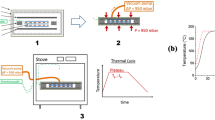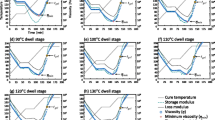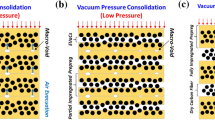Abstract
The present article concentrates on the fabrication of square tube by utilizing high strength carbon fabric epoxy resin prepreg through low cost pressure bag molding technique. In this process vacuum bag which was used has excellent expansion and high thermal stability. The manufactured carbon-epoxy prepreg square tube was evaluated on the basis of fiber volume fraction and mechanical properties such as longitudinal, transverse direction tensile strength. Further, carbon epoxy prepreg composite was manufactured by autoclave technique and compared the mechanical properties fabricated with pressure bag molding as square tube products can be obtained majorly by this technique. The results concluded that, the overall properties of composites manufactured by both the process are almost the same especially tensile strength. However, the specimens manufactured by pressure bag molding process have voids compared to the specimens manufactured by autoclave technique due to vacuum. Nonetheless, pressure bag molding technique can be satisfactorily considered to replace the autoclave technique molding technique and can eventually be applied to manufacture various industrial products such as yacht mast, bicycle frame, tennis racket etc. with low cost.
Similar content being viewed by others
Abbreviations
- a:
-
directional orientation of the system
- h:
-
strip thickness with strip thickness and strip thickness strip thickness
References
Shah, A. U. R., Prabhakar, M., and Song, J.-I., “Current Advances in the Fire Retardancy of Natural Fiber and Bio-Based Composites-A Review,” Int. J. Precis. Eng. Manuf.-Green Tech., Vol. 4, No. 2, pp. 247–262, 2017.
Kim, C. U., Park, J. C., Lee, D. W., and Song, J. I., “Study on Multibody Dynamic Analysis and Durability of Heavy Load Bucket Roller Chain System,” J. Korean Soc. Precis. Eng., Vol. 33, No. 11, pp. 919–925, 2016.
Uusitalo, K., “Designing in Carbon Fibre Composites,” M.Sc. Thesis, Chalmers University of Technology, 2013.
Holmes, M., “Global Carbon Fibre Market Remains on Upward Trend,” Reinforced Plastics, Vol. 58, No. 6, pp. 38–45, 2014.
Zhang, K., Gu, Y., and Zhang, Z., “Effect of Rapid Curing Process on the Properties of Carbon Fiber/Epoxy Composite Fabricated Using Vacuum Assisted Resin Infusion Molding,” Materials & Design (1980-2015), Vol. 54, pp. 624–631, 2014.
Broughton, W., Koukoulas, T., Woolliams, P., Williams, J., and Rahatekar, S., “Assessment of Nanoparticle Loading and Dispersion in Polymeric Materials Using Optical Coherence Tomography,” Polymer Testing, Vol. 32, No. 7, pp. 1290–1298, 2013.
Toray Industries, “Market Research Report: Strategic Business Expansion of Carbon Fiber Trorayca,” 2005.
Tian, T., “Anisotropic Thermal Property Measurement of Carbon-Fiber/Epoxy Composite Materials,” Ph.D. Thesis, The University of Nebraska-Lincoln, 2011.
Campbell, F., “Manufacturing Technology for Aerospace Structural Materials,” Elsevier, 2006.
Akovali, G., “Handbook of Composite Fabrication,” Smithers Rapra Technology, 2001.
Visconti, I. C. and Langella, A., “Analytical Modelling of Pressure Bag Technology,” Composites Manufacturing, Vol. 3, No. 1, pp. 3–6, 1992.
Kar, K. K., “Composite Materials: Processing, Applications, Characterizations,” Springer, 2016.
Kim, B. S. and Lehnhoff, T. F., “Polymeric Composite Tube Fabrication,” Journal of Engineering Materials and Technology, Vol. 117, No. 2, pp. 235–237, 1995.
Lehmann, U., and Michaeli, W., “Cores Lead to an Automated Production of Hollow Composite Parts in Resin Transfer Moulding,” Composites Part A: Applied Science and Manufacturing, Vol. 29, No. 7, pp. 803–810, 1998.
Ghiasi, H., Lessard, L., Pasini, D., and Thouin, M., “Optimum Structural and Manufacturing Design of a Braided Hollow Composite Part,” Applied Composite Materials, Vol. 17, No. 2, pp. 159–173, 2010.
Larsen, E. B., “Pressure Bag Molding: Manufacturing, Mechanical Testing, Non-Destructive Evaluation, and Analysis,” Montana State University-Bozeman, 2004.
Kim, Y., Kumar, S., Choi, C., Kim, C.-G., Kim, S.-W., and Lim, J. H., “Method for Determining Fiber Volume Fraction in Carbon/Epoxy Composites Considering Oxidation of Carbon Fiber,” Composites Research, Vol. 28, No. 5, pp. 311–315, 2015.
Anderson, J. P. and Altan, M. C., “Properties of Composite Cylinders Fabricated by Bladder Assisted Composite Manufacturing,” Journal of Engineering Materials and Technology, Vol. 134, No. 4, Paper No. 044501, 2012.
Salomi, A., Greco, A., Felline, F., Manni, O., and Maffezzoli, A., “A Preliminary Study on Bladder-Assisted Rotomolding of Thermoplastic Polymer Composites,” Advances in Polymer Technology, Vol. 26, No. 1, pp. 21–32, 2007.
Zhu, H., Wu, B., Li, D., Zhang, D., and Chen, Y., “Influence of Voids on the Tensile Performance of Carbon/Epoxy Fabric Laminates,” Journal of Materials Science & Technology, Vol. 27, No. 1, pp. 69–73, 2011.
Olivier, P., Cottu, J., and Ferret, B., “Effects of Cure Cycle Pressure and Voids on Some Mechanical Properties of Carbon/Epoxy Laminates,” Composites, Vol. 26, No. 7, pp. 509–515, 1995.
Zhu, H.-Y., Li, D.-H., Zhang, D.-X., Wu, B.-C., and Chen, Y.-Y., “Influence of Voids on Interlaminar Shear Strength of Carbon/Epoxy Fabric Laminates,” Transactions of Nonferrous Metals Society of China, Vol. 19, pp. s470–s475, 2009.
Author information
Authors and Affiliations
Corresponding author
Rights and permissions
About this article
Cite this article
Park, Sb., Lee, Dw. & Song, Ji. Fabrication and Evaluation of Mechanical Properties of Carbon/Epoxy Square Tube Using Pressure Bag Molding and Compared with Autoclave Method. Int. J. Precis. Eng. Manuf. 19, 441–446 (2018). https://doi.org/10.1007/s12541-018-0053-8
Received:
Revised:
Accepted:
Published:
Issue Date:
DOI: https://doi.org/10.1007/s12541-018-0053-8




